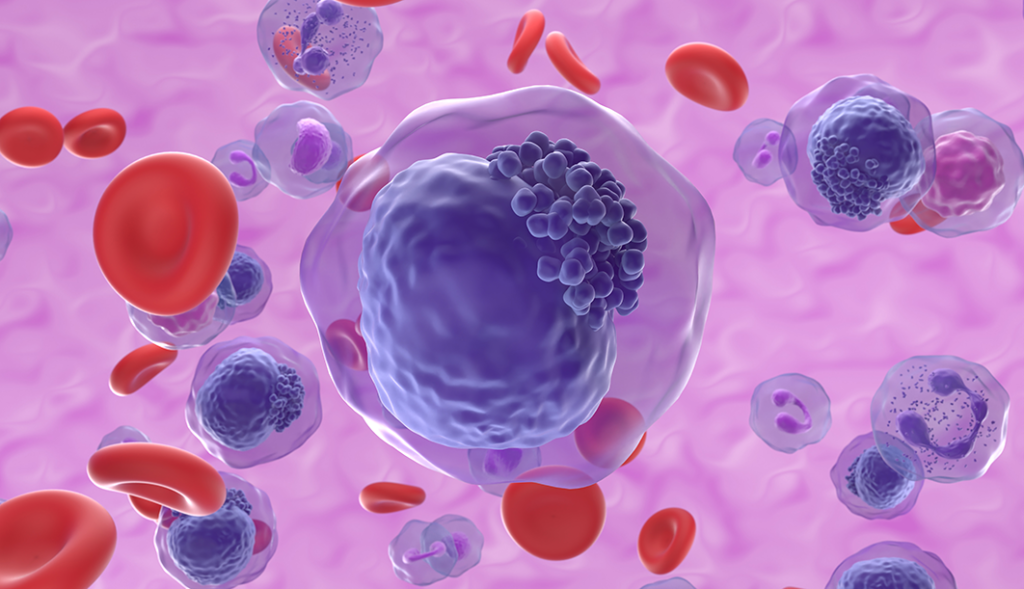Researchers aimed to improve acute myeloid leukemia (AML) patient outcomes after allo-HSCT with new pre-transplant treatment combinations.

The Trending With Impact series highlights Oncotarget publications attracting higher visibility among readers around the world online, in the news, and on social media—beyond normal readership levels. Look for future science news about the latest trending publications here, and at Oncotarget.com.
—
Acute myeloid leukemia (AML) is a cancer of the blood that begins in the bone marrow and progresses quickly if left untreated. AML can occur both in adults and children and is often treated with allogeneic hematopoietic stem cell transplantation (allo-HSCT). Allo-HSCT is a procedure that replaces stem cells that were damaged or destroyed after radiation and/or chemotherapy treatment with stem cells from healthy donors. While allo-HSCT provides a high rate of curability in AML patients, the success of this procedure is partially dependent on the efficacy of pre-transplant treatment regimens. Researchers have identified an urgent need to determine new therapeutic approaches that provide better cytotoxicity in AML cells, without jeopardizing patient safety.
To improve AML patient outcomes after allo-HSCT, researchers from the University of Texas MD Anderson Cancer Center and the University of Alberta’s Cross Cancer Institute conducted a new study investigating the BCL-inhibitor ABT199/venetoclax in combination with two alkylating agents and a nucleoside analog. Their trending research paper was published by Oncotarget on February 10, 2022, and entitled, “ABT199/venetoclax potentiates the cytotoxicity of alkylating agents and fludarabine in acute myeloid leukemia cells.”
“One such candidate drug is ABT199/venetoclax, a BH3-mimetic small molecule that binds to and inhibits the anti-apoptotic B-cell lymphoma 2 (BCL2) protein, preferentially causing malignant cells to undergo apoptosis [10].”
The Study
Previous studies have indicated cytotoxic properties among the alkylating agents busulfan (BU) and 4-hydroperoxycyclophosphamide (4HC), in the nucleoside analog fludarabine (Flu) and in the BCL2 inhibitor ABT199/venetoclax. The researchers in this study investigated the efficacy of ABT199/venetoclax when combined with [Bu+4HC] and [Bu+Flu] in three established AML cell lines: KBM3/Bu2506 (a Bu-resistant AML cell line established in the researchers’ laboratory), OCI-AML3 and MOLM14. They also isolated mononuclear cells taken from seven acute leukemia and myeloid dysplastic syndrome patients and exposed them to these drugs in order to assess their potential clinical implications.
“This study demonstrates a marked potentiation of the cytotoxicity of [Bu+4HC] and [Bu+Flu] when combined with the BCL2 inhibitor ABT199/venetoclax in the KBM3/Bu2506, OCI-AML3 and MOLM14 established AML cell lines.”
Study results showed that, individually, these drugs induced minimal drug-mediated apoptosis. The combination, however, of ABT199 with [Bu+4HC] or [Bu+Flu] exerted significant synergistic cytotoxicity towards AML cell lines. In the isolated mononuclear cells, a negative correlation was observed between the level of BCL2 protein and sensitivity to ABT199. The study found that the [Bu+4HC+ABT199] and [Bu+Flu+ABT199] drug combinations activated multiple biomarkers of apoptosis, increased CASPASE 3-mediated cleavage of MCL1 and MEK1/2, activated stress signaling pathways, and down-regulated pro-survival pathways.
“In summary, our results indicate strong antineoplastic activity of [Bu+4HC+ABT199] and [Bu+Flu+ABT199] towards AML cells.”
Conclusion
The combination of ABT199/venetoclax with alkylating agents and a nucleoside analog showed significant synergistic cytotoxicity towards AML cell lines in vitro. This study provides preclinical evidence for the clinical efficacy of these drug combinations and warrants further investigation in acute myeloid leukemia patients. The results of this study could lead to new, more effective treatment combinations for AML patients undergoing allo-HSCT.
“The results from this preclinical study may be used as the basis for clinical trials using [Bu+4HC+ABT199] or [Bu+Flu+ABT199] as pre-transplant conditioning therapy for high-risk AML patients undergoing allo-HSCT.”
Click here to read the full research paper published by Oncotarget.
ONCOTARGET VIDEOS: YouTube | LabTube | Oncotarget.com
—
Oncotarget is a unique platform designed to house scientific studies in a journal format that is available for anyone to read without a paywall making access more difficult. This means information that has the potential to benefit our societies from the inside out can be shared with friends, neighbors, colleagues, and other researchers, far and wide.
For media inquiries, please contact media@impactjournals.com.




